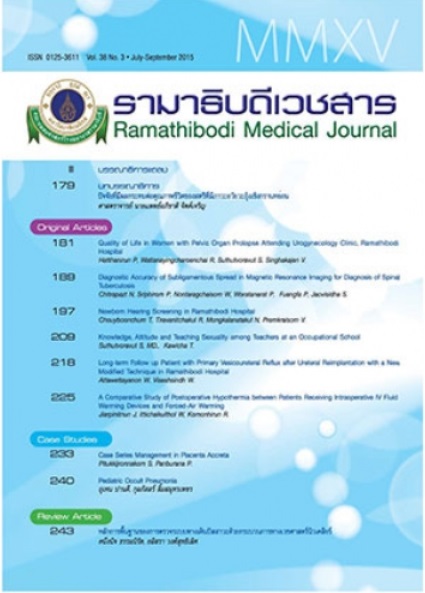Long-term Follow up Patient with Primary Vesicoureteral Reflux after Ureteral Reimplantation with a New Modified Technique in Ramathibodi Hospital
Keywords:
Vesicoureteral reflux, Surgical correctionAbstract
Purpose: To describe the surgical procedure of Modified Glenn-Anderson Technique, a modified technique of ureteral reimplantation, and report our initial experience.
Methods: January 2007 and December 2014, 17 children with primary vesicoureteral reflux (VUR) underwent Modified Glenn-Anderson Technique. All surgical procedures were performed via an open intravesical approach. Postoperative outcome such as urinary tract infection (UTIs), resolved hydronephrosis, operative time and ranged of follow up were analyzed.
Results: Seventeen patients treated with Modified Glenn-Anderson Technique, no patient had intraoperative complication. Mean follow-up was 27 months. When follow with ultrasonography, VUR were complete resolved in 11 patients (64.7%) with 18 ureters and partial resolved in 6 patients with 8 ureters. Febrile UTI was developed in 2 of 17 patients (11.7%) after surgical correction.
Conclusions: Modified Glenn-Anderson Technique is modified technique of ureteral reimplantation, which recreates the neo-ureteric orifice in the orthotopic position. This technique is safe and feasible for correct primary VUR.
References
Austin JC, Cooper CS. Vesicoureteral reflux: who benefits from correction. Urol Clin North Am. 2010;37(2):243-52. doi:10.1016/j.ucl.2010.03.012.
Alsaywid BS, Saleh H, Deshpande A, Howman-Giles R, Smith GH. High grade primary vesicoureteral reflux in boys: long-term results of a prospective cohort study. J Urol. 2010;184(4 Suppl):1598-603. doi:10.1016/j.juro.2010.04.021.
Nelson CP, Hubert KC, Kokorowski PJ, et al. Long-term incidence of urinary tract infection after ureteral reimplantation for primary vesicoureteral reflux. J Pediatr Urol. 2013;9(1):92-8. doi:10.1016/j.jpurol.2011.12.009.
Lee YS, Im YJ, Jung HJ, Hah YS, Hong CH, Han SW. Does hydronephrosis after extravesical ureteral reimplantation deteriorate renal function? J Urol. 2012;187(2):670-5. doi:10.1016/j.juro.2011.10.019.
Peters CA, Skoog SJ, Arant BS Jr, et al. Summary of the AUA guideline on management of primary vesicoureteral reflux in children. J Urol. 2010;184(3):1134-44. doi:10.1016/j.juro.2010.05.065.
Ellsworth PI, Freilich DA, Lahey S. Cohen cross-trigonal ureteral reimplantation: is a one-year postoperative renal ultrasound scan necessary after normal initial postoperative ultrasound findings? Urology. 2008;71(6):1055-8. doi:10.1016/j.urology.2007.11.162.
Lebowitz RL, Olbing H, Parkkulainen KV, Smellie JM, Tamminen-Möbius TE. International system of radiographic grading of vesicoureteric reflux. International Reflux Study in Children. Pediatr Radiol. 1985;15(2):105-9.
Marshall S, Guthrie T, Jeffs R, Politano V, Lyon RP. Ureterovesicoplasty: selection of patients, incidence and avoidance of complications. A review of 3,527 cases. J Urol. 1977;118(5):829-31.
Wiygul J, Palmer LS. The inguinal approach to extravesical ureteral reimplantation is safe, effective, and efficient. J Pediatr Urol. 2011;7(3):257-60. doi:10.1016/j.jpurol.2011.03.007.
Kim KH, Lee YS, Im YJ, Lee CN, Han SW. A modified technique for ureteral reimplantation: intravesical detrusorrhaphy. J Pediatr Surg. 2013;48(8):1813-8. doi:10.1016/j.jpedsurg.2013.05.017.
Khoury AE, Bägli DJ. Vesicoureteral reflux. In: Kavoussi LR, Novick AC, Partin AW, Peter CA, Wein AJ, eds. Campbell-Wash Urology, 10th ed. Philadelphia: Saunders. 2012:3267-309.
Downloads
How to Cite
Issue
Section
License
Copyright (c) 2015 By the authors. Licensee RMJ, Faculty of Medicine Ramathibodi Hospital, Mahidol University, Bangkok, Thailand

This work is licensed under a Creative Commons Attribution-NonCommercial-NoDerivatives 4.0 International License.













